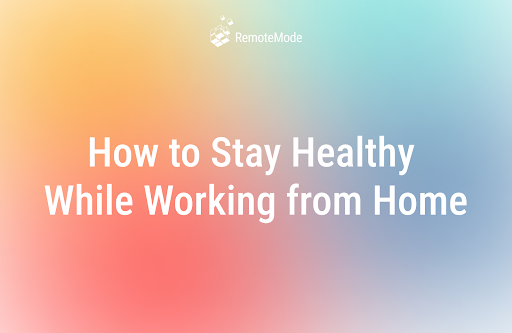5 Tips to Avoid Work-from-Home Burnout

Working remotely—and especially working from home—is a trend that saw an enormous boost during the COVID-19 pandemic. It is a trend that is not receding, even as the number of coronavirus cases diminishes. Studies have shown that remote work policies are good for both employers and employees. Companies save money in overhead costs of buildings, utilities, transportation subsidies, and the like. Workers save money, too, in reduced costs for food (less eating out), transportation (smaller gasoline bills and automobile maintenance or less dependence on public transportation), clothing (comfortable loungewear is much less expensive than a business suit), and so forth.
Businesses that promote working remotely have seen increased productivity in their remote employees. The general fear that workers would slack off if they were not under the constant supervision of management has proven unwarranted. With telecommunications technology at their fingertips, teams stay connected better than ever. Collaboration is just as viable in a video meeting as in a live meeting.
Perhaps even more important for the remote worker is the opportunity to embrace a desirable lifestyle—no commute time, more flexible hours, more time with family and friends or with engaging avocations, and less stress. It’s the ultimate win-win scenario.
Working from home is not all lollipops and roses, however. The remote working arrangement has a dark side. Many remote workers report an increase in the potential for burn-out. In particular, the feeling of always being “on”—virtually accessible 24x7—can take its toll on the psyche. When one “lives” in the office, with the computer always on and the smartphone open to text messages, instant messages, and emails at all hours, it is hard to create a distance between working life and home life.
So, if you are in a work-from-home relationship with your employer or are contemplating a remote work job, how do you keep from slipping into the dark side? Here are five tips that have proven effective in warding off work-from-home burnout.
#1 – Set a schedule
While the up-side to working from home is flexibility, the down-side can also be flexibility—as in, too much flexibility. Ever since the dawn of the industrial revolution, the mindset has been “I work when I’m at work, and I don’t work (or I work differently) when I’m not at work.” So, what happens when there is no boundary between being at work and not being at work? When no commute defines the beginning and ending of your work day, you may find it hard to distinguish between job time and home time.
A solution is to reinvent your commute. Instead of driving for a set number of minutes from your home to your office, you might exercise, read a novel, practice a musical instrument, or some other non-work activity for the same number of minutes. You can similarly recreate the homeward-bound commute. Replace the drive time with something relaxing, like drinking a cup of tea or going for a stroll.
The key is to create a schedule. If you had to hit the road at 7:30AM to get to the office on time, start your in-home commut-ersize regimen at 7:30. If you were back on the road by 4:30PM to fight your way through rush hour traffic, put on the teapot or lace up your walking shoes at 4:30.
The same holds true for lunch and other breaktimes. Knock off for lunch at your traditional time, close the laptop, silence your phone, and eat a healthy lunch from your pantry instead of from a food truck or vending machine. When you normally would take a break at the office, go into another room, put on some music, call a friend, or scratch Fido behind the ears for a few minutes. Use your schedule to create the mental and emotional space you need to separate work time from home time.
#2 – Create a reward system
This technique can work in any situation, but it is particularly effective at home. Set a small, achievable goal and then promise yourself something to celebrate its accomplishment. When you look at your email inbox in the morning, tell yourself you can watch your favorite YouTuber for five minutes after you clear out the last message. Your boss wants that ten-page sales proposal by five o’clock? If you can finish the first two pages in an hour, a piece of chocolate is waiting for you in your drawer. If yoga is your thing, promise yourself three minutes of balasana to relax your back after you’ve entered your fifteenth invoice.
While the work itself may be reward enough for some people, most of us need a little incentive. Keep yourself motivated and focused with an internal contract. Reward yourself not only for finishing a task but for avoiding the myriads of distractions that can lure you off course. The high productivity that employers prize is not about working harder or longer, but about working persistently and consistently. Your personal reward system will translate to productivity for your boss and fun for you.
#3 – Manage your to-do list
Speaking of goals, avoid long-term, unattainable, unmeasurable goals. Or rather, break them down into do-able chunks. You cannot put at the top of your to-do list every day “Complete the six-month project to rewrite the computer system for Accounts Payable.” Sprinting a marathon is a sure-fire recipe for burnout and disaster. But, almost anyone can sprint for five yards. So, turn your 26.2-mile marathon project into a series of 9,222 five-yard sprints. Get set, sprint, pause, celebrate, repeat.
Your daily to-do list is your sprint-ometer. Keep the tasks on it small, manageable, and measurable.
If you are an inveterate list-maker, don’t merge your job to-do list with your personal to-do list. To help keep your working time separate from your non-working time, keep separate lists. When you are working, focus on your job list. When you are not working, focus on your personal list. Avoid the temptation to cross over from one list to another.
#4 – Dedicate a space to work
The notion of place is a powerful psychological concept. Humans learn to associate activities, thoughts, and emotions with particular spaces. Sleep experts, for example, help insomniacs overcome their sleeplessness by directing them to do only one thing in bed—sleep—and not to sleep anywhere else besides in bed. The sufferer’s brain learns to associate sleep with the bed until seeing the bed triggers sleepiness.
The same thing happens with working in the workplace. Though you may not have been conscious of it, when you walked into your place of employment each day, your brain kicked into work mode. When you walked out of the office, your mind entered commute mode. And when you walked through your front door, your brain shifted to home mode. That is why a phone call from a co-worker in the middle of the work day seemed perfectly normal, but that same phone call after dinner generated irritable grumbling. Your at-home brain didn’t want to be interrupted by your at-work brain.
So, to take advantage of this adaptive quirk of human nature by creating a separate workspace in your home. When you are in that space, all you do is work. When you leave that space, leave the work duties behind. If you are lucky enough to have a spare room in your house or apartment, make it your office. Being able to close the door to lock work in or out (depending on which side of the door you are on) is a wonderful advantage. If you don’t have a room, set aside a corner of a room, or even just a particular seat at the kitchen table. The key is to dedicate that space to your work life, and everywhere else is not work. Work only in your workspace, and do not work when you are not in that space. Your brain will catch on and will shift gears effortlessly.
#5 – Take off on your days off
This is a derivative of setting a schedule on a macro scale. Just as you have start and stop times to your workday, you also need start and stop times to your workweek. When you are on, be totally on. And when you are off, be totally off. Although the five-day/forty-hour week is a relatively new invention, it has been around for enough generations that it has become ingrained in the way most people think about work. Just because your office is in your home doesn’t mean you don’t need the recharge time of a weekend. Working 5.71 hours a day seven days a week is more mentally and emotionally exhausting than working 8 hours a day for five days and then taking two days off from work. Create a break in the time/space continuum between the end of one work week and the beginning of the next.
Vacations are also crucial. Health experts will tell you that vacations are not a luxury, they are a necessity to mental, physical, and emotional well being. A week or two away from the job changes your perspective, energizes you, and sets you up for another extended segment of work. It is easy to trap yourself into an unrelenting work cycle. Deadlines are always looming. Assignments keep coming in. If you were working in an office, you would coordinate deadlines around your planned vacation time and make arrangements for someone else to cover your assignments while you are out of the office. The same is true of your home office. Vacation time means you are not “in the office”, not answering emails, and not taking routine phone calls. When you are off work, be truly off work.
Final thoughts
Working remotely can be a marvelous lifestyle with many advantages. It can also, however, be a burden if it is not managed correctly. Along with burnout, work-from-homers can also suffer from social isolation and depression. But these challenges are all manageable with a bit of planning and organization. The result can be a better life with more time and energy for love, laughter, and enjoyment, as well as heightened satisfaction with the job.
The technology sector is one area where remote work is highly feasible and encouraged. If your goal is to live the work-from-home lifestyle, preparation for a remote work tech job is crucial. You can gain the skills to land an excellent remote job in just a few months. Your dream job is not that far away. RemoteMode is the premier training company for remote tech jobs. They offer training in more than a dozen in-demand, high-paying remote career paths. To get ready for your remote work life, contact a RemoteMode career counselor today to learn how quickly you can jump into the remote job market and start living your dream.
Take the first step to your new remote career!






